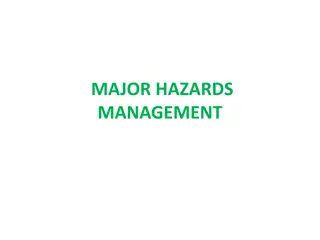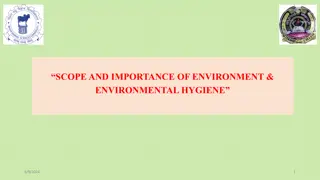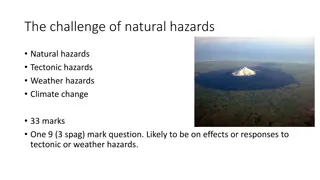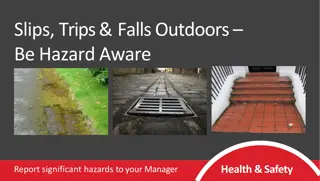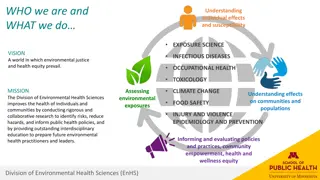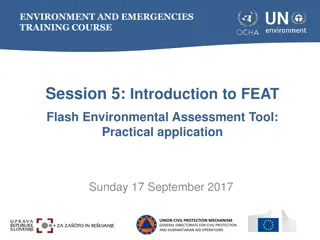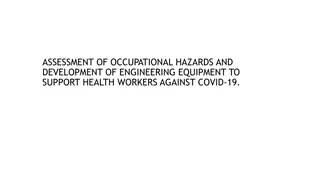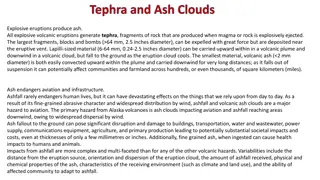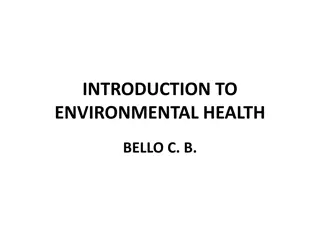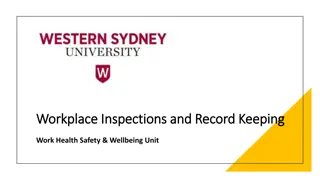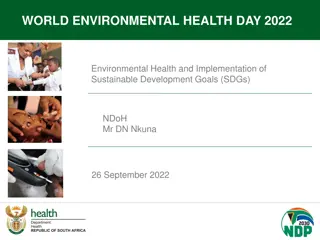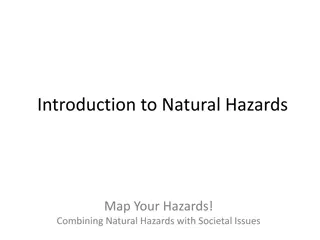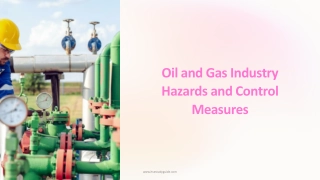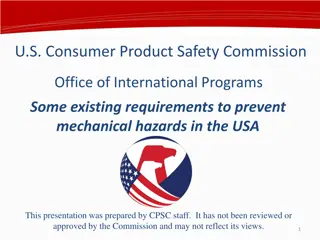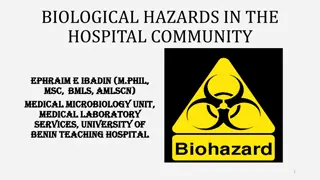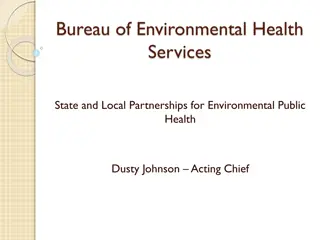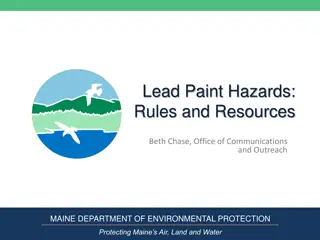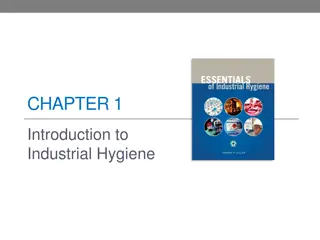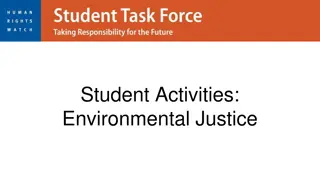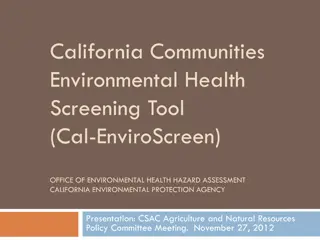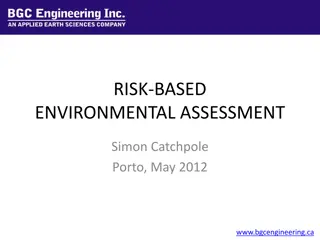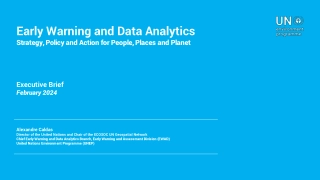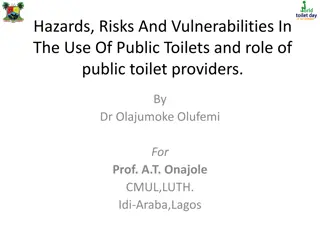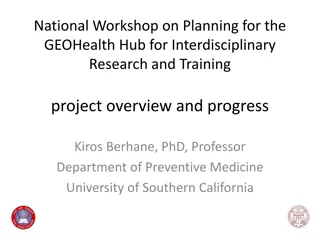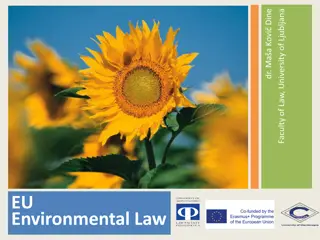Understanding Environmental Health and Hazards
The field of environmental health focuses on preventing human injury and illness by evaluating and limiting exposure to hazardous agents in the air, water, and soil. Various environmental hazards such as water and air pollution, climate change, and occupational hazards pose significant risks to human health. Awareness of sources of hazards and appropriate prevention methods is crucial for promoting well-being and reducing the global burden of environmentally-related diseases.
Download Presentation

Please find below an Image/Link to download the presentation.
The content on the website is provided AS IS for your information and personal use only. It may not be sold, licensed, or shared on other websites without obtaining consent from the author. Download presentation by click this link. If you encounter any issues during the download, it is possible that the publisher has removed the file from their server.
E N D
Presentation Transcript
Introduction & diseases related to environmental health & hazard Objectives To understand the definition of environmental health. To identify the components of the environment. To describe the interaction between different factors with the environment to produce disease. To enumerate different environmental hazard concerns. To describe sources of water hazards. To describe sources of air hazards. To be able to decide on appropriate method for water treatment. To list the steps for environmental risk assessment. Color Index Important Textbook Golden notes Extra Main text Males slides Females slides Doctor notes Editing File
Environment All external factors, living and nonliving, surrounding man Physical environment: Noise and radiation Chemical: Air, toxic waste, pesticides and water Components of the environment: Biological environment: Disease organisms, allergens and insects Social environment: Culture, habits and access to healthcare Environmental Health Environmental health is the science and practice of preventing vvvvvhuman injury and illness and promoting well-being by: Identifying and evaluating environmental sources and hazardous agents and limiting exposures to hazardous physical, chemical, and biological agents in air, water, soil, food, and other environmental media or settings that may adversely affect human health World Health Organization Estimates 23% of global deaths are related to environment Low and middle income countries bare the greatest share of the environmental hazards1 2 1: because the population from those countries are mainly outdoor worker thus higher risk 2: stroke and IHD are the most common causes because they are related to the lifestyle of the population
Environmental Health Concerns Water quality Human industrialization Chemical substances Biological substances Disasters Hazard Climate change Occupational hazard Air quality Disposal of waste How do humans damage the environment? Air Water Soil Biota E.g. smoke E.g. dumping waste in the sea Environmental Chemicals of Concern Lead1 Phthalates Sulfur Dioxide Nitrogen Oxides Carbon Monoxide Radon Ozone Mercury Benzene Toluene Particulate Matter Chromium Volatile Organic Compounds Asbestos Pesticides Arsenic 1. Lead is found in jewelry, toys, paint. a. Primary prevention of lead poisoning: ban the use of lead in such products b. Secondary prevention of lead poisoning: early investigation through blood test and monitoring the levels. Prevention is the same to the all the previous chemicals
Air Quality Air pollution is the introduction of chemicals, particulate matter, or biological materials that cause harmor discomfortto humans or other living organisms, or cause damage to the natural environment or built environment, into the atmosphere. Air pollution An air pollutant is known as a substance in the air that can cause harm to humans and the environment. Pollutants can be in the form of solid particles, liquid droplets1, or gases. In addition, they may be natural or man-made. Pollutants Primary (directly emitted) -Sulphur oxide, Nitrogen oxides, carbon monoxide (CO), CO 2, volatile organic compounds, particulate matter, persistent free radicals, chlorofluorocarbons, ammonia, odors, radioactive material. Secondary (form in air when primary pollutants interact with a third agent) -Ozone2, smog, peroxyacetyl nitrate,Acid rain is formed in the presence of water, with sulfur dioxide or nitrogen oxide. What are the biological consequences of ozone depletion? Increased skin cancer, cortical cataracts, reduction of plankton populations Water Sanitation and Availability Issues with water: Humans need 2 litres of water per day3 Water should be available Should be sanitary In order for water to be safe for human consumption: Free of pathogenic agents Free of harmful chemical substances Pleasant to taste Usable for domestic purposes Volume of water on earth depends on hydrologic cycle: 1. 2. 3. COVID-19 is an example of biological air pollutant Formed by the combination hydrocarbon and nitrogen oxide in the presence of sunlight Variable based on the physical activity, climate change, gender, and age
Sources of water: - Rain. - Surface water: river, stream and lake. - Ground water: wells and springs. Water pollution: Pollution of water due to industrialization (hazardous) -Sewage -Toxic waste -Agricultural pollutants (insecticide, fertilizers) -Heat and radioactive materials Water appears naturally with impurities (not hazardous) -Dissolved gasses: (CO2 , N, H2 S) -Dissolved minerals: (Ca, Mg, Na) -Suspended impurities: (Clay, sand, mud) Water related diseases: Biomedical causes Viral, bacterial, protozoal, helminthic, snail and cyclopes Cyanides, dyes, heavy metals, bleaching agents and ammonia Directly cause disease or indirectly (fish life) Chemical causes Water purification: Depends on source: Wells and springs -> only disinfection Surface water -> needs more treatment 1- Filtration. 2- Storage: To preserve water from further contamination and pollution Provides a small amount of purification Number of bacteria die out Suspended impurities fall by gravity Chemical composition changes ( free ammonia, nitrates) Must be stored within a certain period Prolonged periods cause vegetable growth (algae) 3-Disinfection: Methods for disinfection: 1. Heat1(boiling for 10-20 min kills most organisms and sterilizes water) 2. Chlorination2(kills bacteria but not spores and viruses) 3. Ozonation3 4. Bleaching powder (chlorinated lime) 5. Bromination Challenges with disinfection: Sterilization is impractical at a large scale (only feasible at homes) Chlorination4is the most widely method used Organisms resistant to chlorination (E coli, salmonella, polio, HAV) Decision for disinfection method depends on: Costs; availability of technology and method Like in developing countries Target organism to get rid of Ability to produce residual to provide post-treatment disinfection 1- the most common method and the cheapest (the most used in developing countries) 2- common method 3- Ozonation: is a chemical water treatment technique based on the infusion of ozone into water.is a type of advanced oxidation process, involving the production of very reactive oxygen species able to attack a wide range of organic compounds and all microorganisms. The treatment of water with ozone has a wide range of applications, as it is efficient for disinfection BUT IT S EXPENSIVE AND RARELY USED 4- used in larger scales
Risk Assessment1 Risk assessment in the process of estimating the potential impact of a chemical, physical, microbiological or psychosocial hazard on a specified human population or ecological system under a specific Set of condition and for a certain time frame. In other words, we try to estimate the risk for exposure to a specific hazard in the environment, based on the several assumptions. Environmental risk assessment involves assessing impacts of : Chemical pollutants and contaminants in air, water, soil and food 1 Radiation sources 2 Pathogenic microbiological contaminants in food and water 3 Electromagnetic fields (EMFs) 4 Climate and climate change 5 Things to keep in mind when attempting risk assessment: Heavily relies on assumptions (not what really happens) Does not take into account the different interaction of environment with other factors Exposures and outcomes on which the risk assessment is based are poorly defined Types of environmental risk assessment: Individual and population-based (more common) Quantitative and qualitative Categories of risk vs. numeric estimation 1: The main reason of risk assessment is prevention and report the recommendation to decision makers.
The five stages of environmental hazard risk assessment1: Issue Identification 1 What is the problem in question? Can the problem be addressed by the proposed risk assessment? Do we have the technology and capabilities to apply the assessment process? Are there any factors that contribute to persistence of that risk? Did the risk come about as a breach in public health measures? Hazard Identification 2 How severe are the health effects? And are they reversible? Is there interaction between this hazard and other agents in the environment? Is the onset of the effect immediate or delayed after exposure to hazard? Is there a critical window for exposure? Dose-response Relationship2 3 Does the exposure to the hazard exhibit a dose response relationship for the effect to appear? Is there a critical threshold for exposure? (cut-off point over which the effects will take place) Exposure Assessment 4 What is the nature of exposure? Is there a specific frequency of exposure? Is there a latency period for exposure? Can the critical time of exposure be determined? (In order to be targeted for prevention and control measures) Has the route for exposure been identified? Is there more than one route? Is exposure one time, continuous or intermittent? Risk Characterization 5 Is there genetic variability in exposure to the hazard? Do personal characteristics play a role in exposure to hazard? Or do they play a role in the development of the health outcome following exposure to hazard? Should we consider any population characteristics or dynamics? Prevention and control Monitoring water Biological surveillance of water: Sanitary surveys Inspection of manufacturing of water bottles and ice inspection of reservoirs and wells Establishing policies and procedures for extracting water from wells, and maintaining water safety and storing water Monitoring air pollution By monitoring the concentration of: Sulphur dioxide Smoke Suspended particles 1: Example: a. Dusty weather and asthmatic/COPD patients b. How severe are the exacerbations c.Dose= duration of exposure (For how long) the more the dust the more the exacerbations d. Exposure can be confined to a location for example riyadh more than jeddah thus more cases in riyadh e. Can staying home or wearing masks minimize the risk? 2: for example: the cut-off point for Na+ in the water that if exceeded would lead to intoxication, the more the dose the more the risk
Risk Assessment Issue identification Identification of key issues amenable of risk assessment Hazard assessment Collection and analysis of relevant data 1-Hazard identification - Identify chemicals of potential concern (COPC) 2-Dose - response assessment - Identify relevant toxicity data Exposure assessment - Conceptual site model - Analysis of hazard locations - Identification of exposed populations - Identification of potential exposure pathways - Estimation of exposure concentration and intakes of each pathway - Uncertainty analysis for exposure assessment step Uncertainty analysis for both hazard identification and dose-response assessment Risk characterization - Characterize potential for adverse health effects to occur - Evaluate uncertainty - Summarize risk information Review and reality check Review and reality check Risk Management - Define the options and evaluate the environmental health, economic, social, and political aspects of the options - Make informed decisions Take actions to implement the directions - Monitor and evaluate the effectiveness of the action taken -
Quiz MCQ 1-What is the most serious environmental effect posed by hazardous wastes? A. Air pollution B. Contamination of groundwater C. Increased use of land for landfills D. Destruction of habitat 2-A company would do an outdoor concert in June, they brought a contractor to build a temporary stage, and the concert was informal. Which of the following hazards could happen? A) Hypothermia, trauma injury, food poisoning B) Hyperthermia, trauma injury, food-borne diseases C) Hypothermia, poor airway circulation, air pollution D) Heat stroke, poor airway circulation, food-borne diseases 3-Exposure to which of the following hazardous materials results in instantaneous reactions? A. Aerosolized zinc B. Ammonia gas C. Asbestos D. Lead 4-What is the first stage of risk assessment? A. Exposure assessment B. Issue identification C. Toxicity study D. Risk characterization 5-What is the main objective of risk characterisation? A. Estimation of the potential for adverse health or ecological effects to occur from exposure to a stressor B. Determination of pathways C. Estimation of exposure D. Collection of data Q1 Q2 Q3 Q4 Q5 Answers A B B B A
Thank You and Good Luck Team Leaders: Lama AlAssiri | Mohammed AlHuqbani | Ibrahim AlDakhil Team Members: Sara AlAbdulkareem Deema AlMaziad Hameed M. Humaid Sedra Elsirawani Lama AlZamil Khalid Alkhani Wejdan Alnufaie Leen AlMazroa Meshari Alzeer Abdulrahman Alhawas Lina AlOsaimi Mohannad Makkawi Abdulrahman Shadid Muneera AlKhorayef Nayef Alsaber Abdullah Aldawood Norah AlHarbi Omar Aldosari Abdullah Shadid Norah AlMazrou Omar Alghadir Alwaleed Alsaleh Nouf Alhussaini Zyad Aldosari Bader Alshehri Razan AlRabah Bassam Alkhuwaiter Renad Alhaqbani Faisal Alqifari Rema AlMutawa


